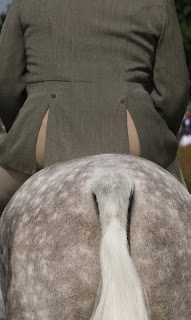 A rider that is too heavy for a horse could cause temporary
lameness and signs of pain according to recent research.
A rider that is too heavy for a horse could cause temporary
lameness and signs of pain according to recent research.
The potential health and welfare implications of a high
rider:horse bodyweight ratios were explored in a pilot study led by Dr Sue
Dyson, Head of Clinical Orthopaedics at the Animal Health Trust’s Centre for
Equine Studies, Newmarket.
Six horses were used for the study. All were in regular work
and were not lame. They were ridden by each of four riders of differing weights:
Light (L), Moderate (M), Heavy (H) and Very Heavy (VH).
The riders each performed a standard 30‐min ‘dressage‐test'.
The research team looked for signs of lameness (graded 0-8) and behavioural signs
of pain (scored 0-24). The test was abandoned if signs of lameness reached 3 or
more in one limb or 2 or more in multiple limbs. Lameness was assessed by Dyson
and confirmed using objective gait assessment date from inertial measurement
units placed over the pelvis, withers and poll.
Similarly, if 10 or more behavioural markers
of pain, (such as ears being held back, constant moving of head, tail lashing) were seen,
the test was stopped.
The researchers found that all 13 H and VH rider tests were abandoned
(12 for lameness and one for pain-associated behaviour). In contrast, only one
of 12 M rider tests was abandoned for lameness.
They reassessed the horses moving in hand 45–60 min
after any abandoned test. At that stage all horses trotted sound. At the end of
the study, all horses moved well when ridden.
The conclusion was that large riders can induce temporary
lameness and behaviours consistent with musculoskeletal pain. The researchers
suggest that this may relate to rider bodyweight and/or weight distribution. They
noted that moderate and heavyweight riders had markedly different test
abandonment rates, despite having similar Body Mass Index (BMI). So, they
suggest that bodyweight is probably more relevant than BMI.
Dyson said: “The results indicate that every rider and
especially heavier riders should ride a horse or pony of appropriate size and
fitness for the rider’s weight, with a saddle that is correctly fitted for both
horse and rider.”
The open access article is available online. For more
details, see:
The influence of rider:horse bodyweight ratio and
rider‐horse‐saddle
fit on equine gait and behaviour: A pilot study.
S. Dyson, A. D. Ellis, R. Mackechnie‐Guire, J. Douglas, A. Bondi, P. Harris
Equine Veterinary Education (2019)

4 comments:
Agree wholeheartedly, although there will always be the person who says their stocky, 14H mare is ridden regularly by her 225-lb husband with no negative impact.
I've been reading articles that say newer studies show 10% of the horse's weight is the new max. Do you agree with that or is it still 20%?
Well my horses have had heavier riders my 15.3hh mare had my 90 kg mate she wasnt use to it but came round she defnitely preferred my small weight after
The official advice on maximum weight to be carried is still, so far as I can find out, 20% but, of course, that includes the weight of the rider, saddle, girth, pads, stirrup leathers and stirrups - metal ones can be quite heavy. It is also reasonable to add in the bridle and bit and any martingale or other gadget used. To say that an animal is a 'weight-carrier' is not, in my view, a reason to overload it, particularly in relation to native ponies carrying adults. The fact that they used to carry farmers all day over hill and dale and still be on their feet at the end of it is not a reason to abuse them so today, with our supposedly improved welfare principles. The 20% only applies to fit, strong horses in their middle years. Young, old and unfit ones can carry less (unofficially), as can those working at fast gaits and for longish periods of time.
Gillian Cooper
I once watched a documentary on how the cow is built more for carrying the weight of the rider than a horse. I evolved out of the saddle years ago. Its so very freeing.
Post a Comment